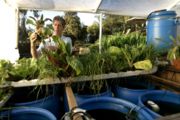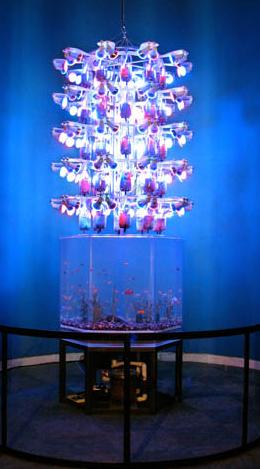Difference between revisions of "Food/Aquaponics"
m (Food/Aquaculture and aquaponics moved to Food/Aquaponics) |
|||
| Line 3: | Line 3: | ||
Hydroponics is growing plants in water. Aquaculture is growing fish in tanks. The disadvantage of hydroponics is the constant input of mineral nutrients it needs. The disadvantage of aquaculture is the difficulty of keeping the water clean. Aquaponics combine the two systems and thereby cancels out the weaknesses of both. | Hydroponics is growing plants in water. Aquaculture is growing fish in tanks. The disadvantage of hydroponics is the constant input of mineral nutrients it needs. The disadvantage of aquaculture is the difficulty of keeping the water clean. Aquaponics combine the two systems and thereby cancels out the weaknesses of both. | ||
| − | In aquaponics, edible fish are grown in a tank. The fish eat the algae that will grows naturally in nearly any still body of water. The fish effluent enriches the water with nutrients. This water then serves as the medium to grow hydroponic herbs and vegetables. The roots of the herbs and vegetables filter the water, which make it cleaner for the fish. Both the fish and the plants (and sometimes the algae) can be eaten by humans. | + | In aquaponics, edible fish are grown in a tank. The fish eat the algae that will grows naturally in nearly any still body of water, or pond weeds can be grown. The fish effluent enriches the water with nutrients. This water then serves as the medium to grow hydroponic herbs and vegetables. The roots of the herbs and vegetables, and the bacteria that grow around them, filter the water, which make it cleaner for the fish. Both the fish and the plants (and sometimes the algae) can be eaten by humans. |
| − | Many aquaponics systems also include a wormery, which uses the inedible parts of the plants to feed worms. The worms are then fed to the fish and the compost they produces can be used to nourish more plants. | + | Many aquaponics systems also include a wormery, which uses the inedible parts of the plants to feed worms. The worms are then fed to the fish and the compost they produces can be used to nourish more plants. This brings the system closer to a fully closed-loop, recycling all its waste. |
| − | It should be apparent from this description that aquaponics is an extremely resource-efficient method of food production. It requires 10% the [[Fundamental resources/Water|water]] of growing vegetables in soil, because the water is constantly recycled rather than draining away. | + | It should be apparent from this description that aquaponics is an extremely resource-efficient method of food production. No fertilizers are needed and there is no pollution. It is really the only [[Survival of our species/Long-term thinking|sustainable]] way of producing fish; much more sustainable than conventional fish-farming and certainly more sustainable than current fishing practices. In theory an aquaponic system could be run without external input (though in practice calcium and other minerals often need to be supplied.) Aquaponics requires 10% the [[Fundamental resources/Water|water]] of growing vegetables in soil, because the water is constantly recycled rather than draining away. This means that aquaponic farms nearly anywhere in the world can run on rainwater alone. |
| + | |||
| + | Aquaponics is extremely productive. The plant yields compare favorably with hydroponics, and are much higher than growing in soil. Some research even points to the possibility of achieving much higher yields with aquaponics than even with hydroponics<sup>[http://www.greenhousecanada.com/content/view/965/67/]</sup>. | ||
| + | One very well-designed system<sup>[http://ag.arizona.edu/azaqua/ista/ista6/ista6web/pdf/676.pdf]</sup> grows over 4000kg of tilapia and over 2500kg of okra yearly and takes up just 500m<sup>2</sup>. | ||
[http://www.thegreencenter.net/ The New Alchemy Institute] found that a fish tank five feet in diameter and five feet tall can produce forty pounds of fish a year. (Meaning that you could have fish for dinner twice a week.) They perfected the method for growing tilapia, catfish or shrimp and even developed computer algorithms which could accurately predict the yield of fish based on variables [http://www.thegreencenter.net/pdf/solaraqua.pdf]. | [http://www.thegreencenter.net/ The New Alchemy Institute] found that a fish tank five feet in diameter and five feet tall can produce forty pounds of fish a year. (Meaning that you could have fish for dinner twice a week.) They perfected the method for growing tilapia, catfish or shrimp and even developed computer algorithms which could accurately predict the yield of fish based on variables [http://www.thegreencenter.net/pdf/solaraqua.pdf]. | ||
| + | |||
| + | There is a lot of research being done into how to optimize aquaculture systems. Over the next few years, we will gain much better knowledge of what it takes to create a productive, sustainable aquaculture system. This will make aquaponics even more appealing than it is now. Conservatively, it should be possible, now or within the next few years, to feed a person with healthy fish and vegetables produced in 100m<sup>2</sup> of greenhouse space with virtually no input. | ||
{|style="border-spacing:8px;margin:-8px -8px" | {|style="border-spacing:8px;margin:-8px -8px" | ||
|class="MainPageBG" style="width:100%;border:1px solid #ddcef2;background-color:#faf5ff;vertical-align:top;color:#000"| | |class="MainPageBG" style="width:100%;border:1px solid #ddcef2;background-color:#faf5ff;vertical-align:top;color:#000"| | ||
{|cellpadding="2" cellspacing="5" style="vertical-align:top;background-color:#faf5ff;color:#000" | {|cellpadding="2" cellspacing="5" style="vertical-align:top;background-color:#faf5ff;color:#000" | ||
| − | ! <h2 style="margin:0;background-color:#ddcef2;font-size:120%;font-weight:bold;border:1px solid #afa3bf;text-align:center;color:#000;padding:0.2em 0.4em;"> | + | ! <h2 style="margin:0;background-color:#ddcef2;font-size:120%;font-weight:bold;border:1px solid #afa3bf;text-align:center;color:#000;padding:0.2em 0.4em;">Farm Fountain</h2> |
|- | |- | ||
| − | |style="color:#000"|<div style="text-align: center;"><p>[[Image:Farmfountain.jpg]]</p><p> [http://farmfountain.com/ Farm Fountain] is 'a sculptural ecosystem you can eat'. It shows how aquaponics can be applied as a vertical farming method. The design, by Ken Rinaldo and Amy Youngs, is available under a Creative Commons license and their website gives instructions on [http://farmfountain.com/howto/index.html how to build your own]. The fish tank at the bottom produces edible fish and effluent-enriched water, which is circulated among the bottles above, where plants are grown hydroponically.</p></div> | + | |style="color:#000"|<div style="text-align: center;"><p>[[Image:Farmfountain.jpg]]</p><p> [http://farmfountain.com/ Farm Fountain] is 'a sculptural ecosystem you can eat'. It shows how aquaponics can be applied as a vertical farming method. The design, by Ken Rinaldo and Amy Youngs, is available under a [[Open collaborative design|Creative Commons license]] and their website gives instructions on [http://farmfountain.com/howto/index.html how to build your own]. The fish tank at the bottom produces edible fish and effluent-enriched water, which is circulated among the bottles above, where plants are grown hydroponically.</p></div> |
|- | |- | ||
|} | |} | ||
Revision as of 10:57, 30 October 2010
Hydroponics is growing plants in water. Aquaculture is growing fish in tanks. The disadvantage of hydroponics is the constant input of mineral nutrients it needs. The disadvantage of aquaculture is the difficulty of keeping the water clean. Aquaponics combine the two systems and thereby cancels out the weaknesses of both.
In aquaponics, edible fish are grown in a tank. The fish eat the algae that will grows naturally in nearly any still body of water, or pond weeds can be grown. The fish effluent enriches the water with nutrients. This water then serves as the medium to grow hydroponic herbs and vegetables. The roots of the herbs and vegetables, and the bacteria that grow around them, filter the water, which make it cleaner for the fish. Both the fish and the plants (and sometimes the algae) can be eaten by humans.
Many aquaponics systems also include a wormery, which uses the inedible parts of the plants to feed worms. The worms are then fed to the fish and the compost they produces can be used to nourish more plants. This brings the system closer to a fully closed-loop, recycling all its waste.
It should be apparent from this description that aquaponics is an extremely resource-efficient method of food production. No fertilizers are needed and there is no pollution. It is really the only sustainable way of producing fish; much more sustainable than conventional fish-farming and certainly more sustainable than current fishing practices. In theory an aquaponic system could be run without external input (though in practice calcium and other minerals often need to be supplied.) Aquaponics requires 10% the water of growing vegetables in soil, because the water is constantly recycled rather than draining away. This means that aquaponic farms nearly anywhere in the world can run on rainwater alone.
Aquaponics is extremely productive. The plant yields compare favorably with hydroponics, and are much higher than growing in soil. Some research even points to the possibility of achieving much higher yields with aquaponics than even with hydroponics[1]. One very well-designed system[2] grows over 4000kg of tilapia and over 2500kg of okra yearly and takes up just 500m2.
The New Alchemy Institute found that a fish tank five feet in diameter and five feet tall can produce forty pounds of fish a year. (Meaning that you could have fish for dinner twice a week.) They perfected the method for growing tilapia, catfish or shrimp and even developed computer algorithms which could accurately predict the yield of fish based on variables [3].
There is a lot of research being done into how to optimize aquaculture systems. Over the next few years, we will gain much better knowledge of what it takes to create a productive, sustainable aquaculture system. This will make aquaponics even more appealing than it is now. Conservatively, it should be possible, now or within the next few years, to feed a person with healthy fish and vegetables produced in 100m2 of greenhouse space with virtually no input.
|

